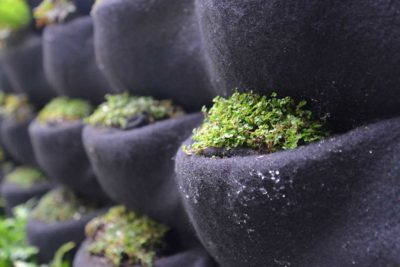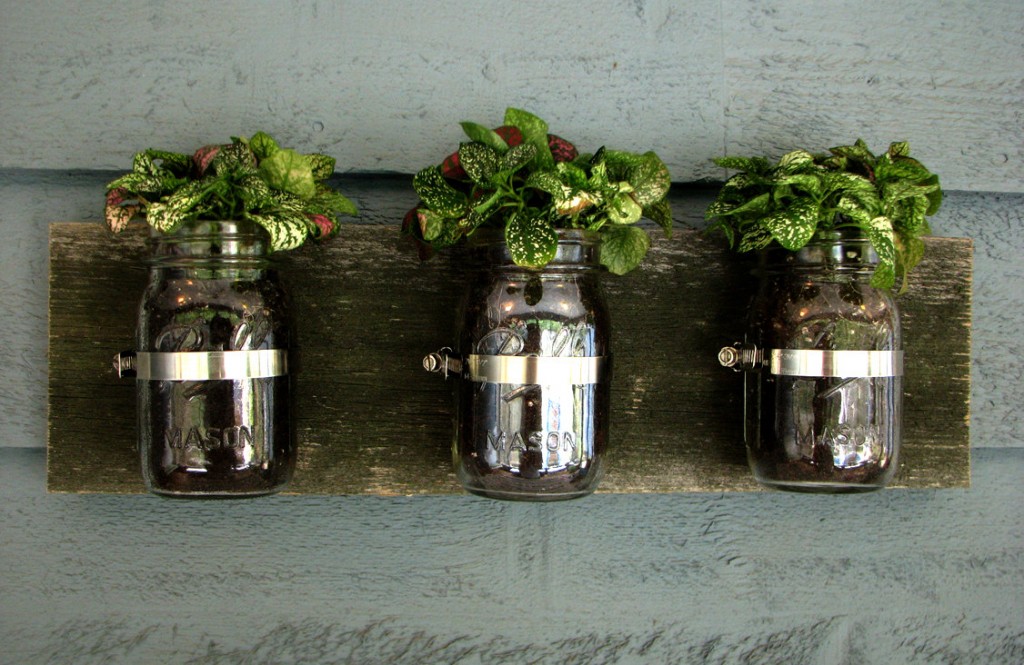Living walls are popping up more frequently in home design. These “walls” (which may be an entire wall or just a picture-frame type installation) are often planted with succulents. They are aesthetically stunning and bring a range of advantages into your home, including improved air quality and the buffering of acoustics. They also can lower anxiety and increase attentiveness and productiveness.
What if living walls were reimagined with edible plants like herbs? What if we also could harness all the benefits of growing culinary produce, like saving money and having better-tasting food? Would you do it? After researching how to do it, I know I will! I’m excited to get started.
While it may not be possible to create an actual “living wall” of herbs, due to the size of mature herbs and their growing characteristics, we certainly can create vertical gardens against the walls in our homes.
Depending on how much you want to spend, and how much of a DIYer you are, there are all kinds of options for indoor vertical gardening. You can buy fabric or plastic wall pockets simply to attach to your walls. You can build your own systems from jars or bottles and scraps of lumber. Or you can reach deep inside your wallet and buy a freestanding vertical garden unit.
Fabric Wall Pockets
You know those over-the-door shoe holders, made from a length of fabric with rows of small plastic pockets for your shoes? While you can actually use those for outdoor vertical gardening, they aren’t recommended for indoor use because the fabric isn’t water resistant and would likely  ruin your walls. However, several companies make similar fabric wall pockets specifically for growing plants indoors. Make sure you choose those that are waterproof, or that have reservoirs for retaining water. Wall pockets are an extremely economical choice and they are easy to install. And it’s easy enough to build a wooden frame to attach the pockets to, if you wish to up the style quotient.
ruin your walls. However, several companies make similar fabric wall pockets specifically for growing plants indoors. Make sure you choose those that are waterproof, or that have reservoirs for retaining water. Wall pockets are an extremely economical choice and they are easy to install. And it’s easy enough to build a wooden frame to attach the pockets to, if you wish to up the style quotient.
Mason Jar Planters
If you have a rustic country-style decor, this will suit your space quite well — and it’s a very easy DIY project. All you need to do is attach heavy-duty stainless steel hose clamps to a strip of lumber. Securely clamp in mason jars, with a clamp encircling the center of each jar, and you are ready to plant.
This New All-Natural Fertilizer Can Double Your Garden Yield!
Start by cutting 1×4 or 1×6 lumber to your desired length. If you want to paint, stain or otherwise prep the lumber, do so before proceeding to the next step, which is screwing on the clamps. Make sure you choose clamps that will fit the circumference of the jars you will be using.
Depending on your space, the board can be hung either vertically or horizontally. Comfortably space the clamps on the board, keeping in mind the size of mature herbs. If your board will be hung vertically, then attach your clamps so that your jars are tilted at about a 45-degree angle. This way, the jar above won’t hinder the herbs’ growth, and the jars can be placed closer together, making better use of your available space.
For a super-economical and eco-friendly version of this project, recycle plastic pop bottles instead of using mason jars. Just cut the tops off the bottles and screw the bottles directly to the board.
Framed Balcony Box Planters
Picture this: a large window-frame type structure — about 6 inches deep and 24 inches across. The height will depend on how many plastic rectangular balcony-style planters you want to place in it. Use cleats on the inside of the vertical pieces to hang your baskets. The planters will be easy to remove from the frame for maintenance or replanting. Cross braces on the back of the frame will strengthen your structure and keep the planters from touching the wall. This type of structure is easy to build, even for those with the most basic carpentry skills, and it is easily customizable to fit your available space. While a pre-fab shelving unit may be easier to put together, you may end up with wasted space surrounding your planters, and the shelves might get damaged by water.
Buying Freestanding Vertical Wall Gardens
If you have the money to spend and you don’t get itchy fingers over DIY projects, there’s a wide assortment of freestanding vertical wall gardens available for purchase. These can be placed against existing walls, or they work beautifully as room dividers. A little Internet research will turn up a slew of these systems.
Building (or buying!) your vertical herb garden structure is just the beginning of the fun. You’ll also need to pick out your herbs. If you’re creating a few smaller gardens, like a couple of wooden mason jar boards, why not create a themed herb garden in each? One could be for Italian herbs, like rosemary, basil, thyme and oregano, and another for tea herbs, like various mints. Whatever you end up doing, have fun, and enjoy using your fresh herbs all winter long.
Have you ever built or planted a wall garden? What advice would you add? Share your tips in the section below:
Bust Inflation With A Low-Cost, High-Production Garden. Read More Here.
 Off The Grid News Better Ideas For Off The Grid Living
Off The Grid News Better Ideas For Off The Grid Living




